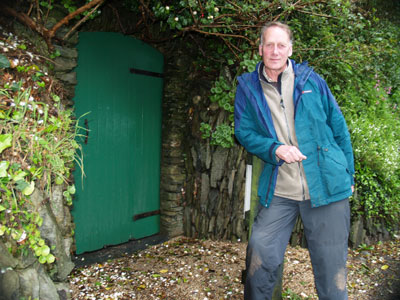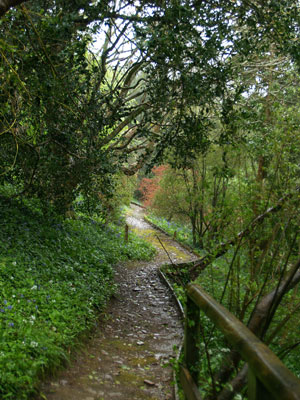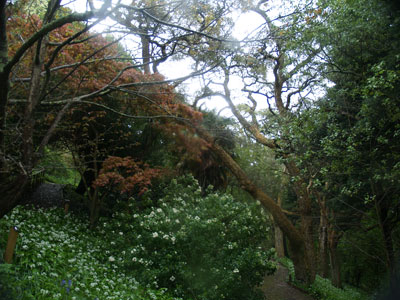South Devon’s ‘secret’ Blackpool Gardens
This item appears on page 59 of the December 2012 issue.
In May 2003 I traipsed behind Geoffrey Newman on a weeklong trek with The Wayfarers titled “Dorset Gardens: Rambles and Roses” (April ’04, pg. 42). The Wayfarers, a UK touring company, has run tours through the English countryside and beyond for close to 30 years.
Wayfarers guide Geoffrey Newman, with measured tread and engaging charm, led our group from garden to garden. Only at the end of the trip, when Geoffrey mentioned that he was restoring his own family’s historic garden, did I learn we’d been traipsing after Sir Geoffrey Newman.
It wasn’t until April 2012 that I made my way to England’s South Devon to visit with Sir Geoffrey. Overlooking an idyllic curve of coastline, a hop and a jump from Dartmouth, his Secret Seaside Gardens of Blackpool are now open for public wandering.
Sir Geoffrey inherited the garden from a line of Newmans that dates back to swashbuckling, seafaring Richard Newman, who sailed out of Dartmouth Harbour and established the family’s fortune trading in cod, wine and spices. . . along with other activities.
“Pirating?” I asked Sir Geoffrey, who cheerfully nodded ‘Yes’ over his cup of tea as we chatted in Blackpool Sands’ seaside café before visiting the garden.
“Well, actually, not a pirate,” he clarified, “a privateer authorized by the crown to attack foreign shipping.”
In 1796 Richard Newman bought Blackpool cove. As the years passed, the Newmans gradually purchased the cove’s surrounding coastline to establish a holding extending from Dartmouth to the Start Point Lighthouse 10 miles to the south.
“The purpose was not to acquire land for the sake of just owning it,” Sir Geoffrey said. “Instead, it was always with a view to preservation.”
Today the entirety of the family’s holdings on South Devon’s Heritage Coast is designated an Area of Outstanding Natural Beauty (AONB).
Sir Geoffrey’s grandfather, Robert Lydston Newman, Deputy Governor of the Bank of England, treasured holiday weeks at Blackpool, taking his little boat out into the sea and puttering about the place. In 1896 he began to establish a garden, a “plantsman’s garden,” Sir Geoffrey told me, one designed to showcase specimens gathered from the far corners of the world, as was the Victorian fashion of the time.
The Victorian era was a fascinating time in England’s garden history. A powerful upper class and powerful navy traveled the world’s oceans, returning with exotic plants, cuttings and seeds unknown to English gardens. The country’s southwest coast, warmed by the sun and heat-collecting granite outcroppings, proved exceptionally welcoming to the semitropical plants gathered from the four corners of the world.
Grand estate gardens emerged, “show-off” gardens filled with acres of the weird and wonderful, planted with an eye to impress. By contrast, Sir Geoffrey’s family garden more represents that of an inquisitive hobbyist in which one plant led to the searching out of another… and another.
“While many estates jealously guarded their acquisitions,” Sir Geoffrey said, “many specimens in our garden resulted from my grandfather and father visiting neighboring Devon and Cornwall estates and asking, ‘Might I have a bit of that?’ and carrying home a cutting or seeds.”
Go back some 70 years and Blackpool’s idyllic cove was strictly for the enjoyment of the Newmans. World War II changed all that. US Marines requisitioned Blackpool Sands in order to rehearse the D-Day landings. Once the war was over, the fences never went back up.
The war changed more than public access. While the garden continued to be cared for into the 1970s (Sir Geoffrey remembers his mother cutting greenery to send on to London’s florists), economics deemed it no longer a priority. Weather and time had its way.
In spring 2000 Sir Geoffrey set about a restoration partially funded by European Community Regional Development Fund money. Underbrush and brambles were laboriously removed. With an eye to opening the garden to visitors, gently sloped paths were installed, gradually leading to the Captain’s Seat, a bench where one can enjoy spectacular views over the sea.
New areas were cleared with an eye to continuing the gardens as a plantsman’s collection; at the time of my visit, Sir Geoffrey had just returned from a New Zealand specimen-scouting tour.
It was time for us to visit the gardens, its entrance via a small green door cut into a high stone wall on the far side of the coastal road (hence, the “Secret Seaside Gardens”).
As we set out on the path, Sir Geoffrey pointed out one of the oldest specimens on the family’s land, a California Monterey pine planted in 1848. I marveled at its majestic height and straightness, quite unlike the wind-sculpted, bent trees iconic of California’s Monterey Peninsula.
We continued past a long stand of enormous cork oak, collected in North Africa and planted as saplings in 1896 as an evergreen belt to buffer the garden from salt-laden winds.
As we walked the paths, I stopped to admire colorful patches of spring wildflowers, emerged as undergrowth, with Sir Geoffrey commenting, “Wildflowers, yes, but you’ll find no pretty, little, regimented flower beds planted here. That’s not the garden’s intent.”
An intent that was made clear as Sir Geoffrey introduced me to trees and shrubs as if to old friends, giving botanical names, where each came from, its date of entry into the garden and information gleaned from a lucky find of a generational-kept ledger — Chusan palm, central China,1920; Buddleia auriculata, South Africa, 1921; Feijoa sellowiana, Brazil, 1909… .
And on it went. A collector’s garden, a plantsman’s garden, a garden married to the landscape, a garden reflecting a family’s care and generational interest in preserving the area, a garden Sir Geoffrey hopes will continue through Newmans to come.
The Secret Seaside Gardens of Blackpool (phone 01803 771801) are part of the recreational area Blackpool Sands (Blackpool, Dartmouth, Devon, TQ6 0RG, U.K.; phone 01803 771800), which includes a café plus watersports equipment rentals.
Located on coastal road A379 between Stoke Fleming and Strete in South Devon, they’re open daily 10 a.m. to 4 p.m. from April to the end of September. The admission cost is £3 (near $5) per adult, with children free.
Visitors are advised to wear sturdy footwear and understand that paths can be wet and slippery.



